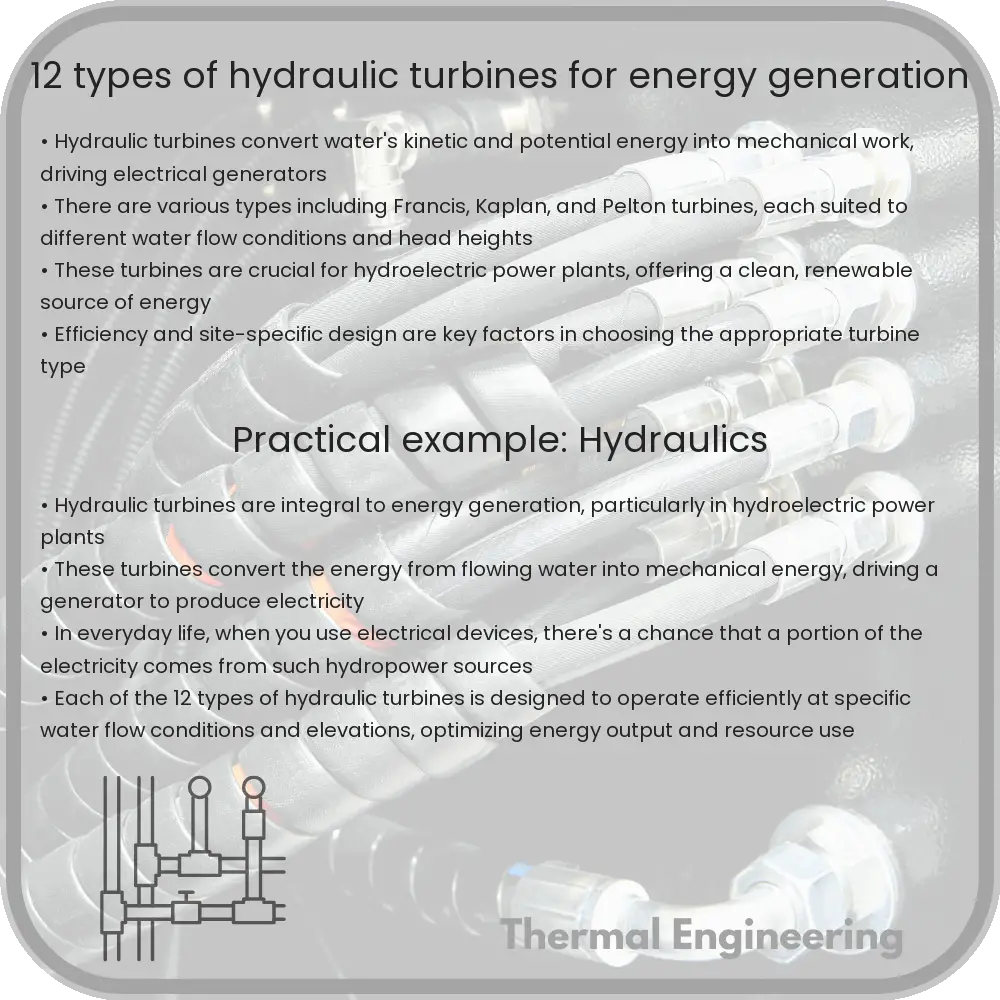Learn about 12 types of hydraulic turbines used in hydroelectric power generation, each suited for specific water flow and head conditions.

Understanding Hydraulic Turbines: 12 Types for Energy Generation
Hydraulic turbines are devices used in hydroelectric power plants to convert the energy of flowing water into mechanical energy, which is then converted into electrical energy through generators. There are several types of hydraulic turbines, each designed to operate efficiently at specific water flow rates and head conditions. In this article, we will explore 12 common types of hydraulic turbines used for energy generation.
1. Pelton Wheel
The Pelton wheel is an impulse turbine designed to operate in high-head, low-flow conditions. It features bucket-shaped blades that convert the kinetic energy of water into rotational motion. Water jets strike the blades, creating a force that causes the wheel to rotate. This type of turbine is ideal for mountainous regions where high water head is available.
2. Francis Turbine
The Francis turbine is a reaction turbine that works well under medium to high head and medium flow conditions. It has a spiral casing that directs water through vanes on a runner, causing it to spin. This turbine is one of the most common types, used widely due to its versatility and efficiency.
3. Kaplan Turbine
Kaplan turbines are reaction turbines designed for low head and high flow conditions. They feature adjustable blades that allow for optimal performance at varying flow rates. The turbine’s ability to adjust blade angles makes it particularly effective in rivers and low gradient applications.
4. Turgo Turbine
The Turgo turbine is an impulse turbine similar to the Pelton wheel but designed to handle a bit more water flow at a slightly lower head. It uses a jet of water directed at an angle to the runner, allowing for efficient energy extraction with less water volume compared to the Pelton wheel.
5. Crossflow Turbine
Also known as a Michell or Banki turbine, the Crossflow turbine features a drum-like rotor with blades that water flows through twice, enhancing efficiency. This design is effective in applications with low head and medium flow.
6. Tyson Turbine
The Tyson turbine is a variant of the Kaplan turbine, designed specifically for very low head and high flow conditions. It maximizes energy extraction in shallow rivers and streams, making it an excellent choice for small scale hydro power projects.
7. Gorlov Helical Turbine
Designed for capturing energy from flowing water in all directions, the Gorlov helical turbine has a helical shaped rotor that operates similarly to a Darrieus wind turbine. It’s particularly useful in tidal energy generation and river applications where water flow direction varies.
8. Jonval Turbine
The Jonval turbine is an older design, not commonly used today. It features vertical blades and operates under a reaction mechanism, suitable for low head and medium flow conditions.
9. Ossberger Turbine
Also known as a Banki-Crossflow turbine, the Ossberger turbine improves on the original crossflow design by maximizing efficiency and ease of maintenance. It is versatile across a range of flow conditions and is often used in small hydroelectric projects.
10. Deriaz Turbine
The Deriaz turbine, a reaction turbine similar to the Kaplan but with inclined blades, is suited for medium head and high flow conditions. Its adjustable blades enhance efficiency and control, making it suitable for varying operational requirements.
11. Bulb Turbine
The Bulb turbine incorporates a bulb-shaped housing around the generator, located directly in the water stream, typically used in tidal and low head river applications. This positioning allows for direct drive of the generator, minimizing energy losses.
12. Straflo Turbine
The Straflo turbine features a unique design where the generator is integrated into the periphery of the turbine’s rim, making it highly efficient and compact. It is typically used in low head and high flow scenarios.
Each type of hydraulic turbine has specific characteristics that make it suitable for certain environmental and operational conditions. By matching the right turbine type with the specific conditions of a hydroelectric project, engineers can maximize the efficiency and output of power generation systems.